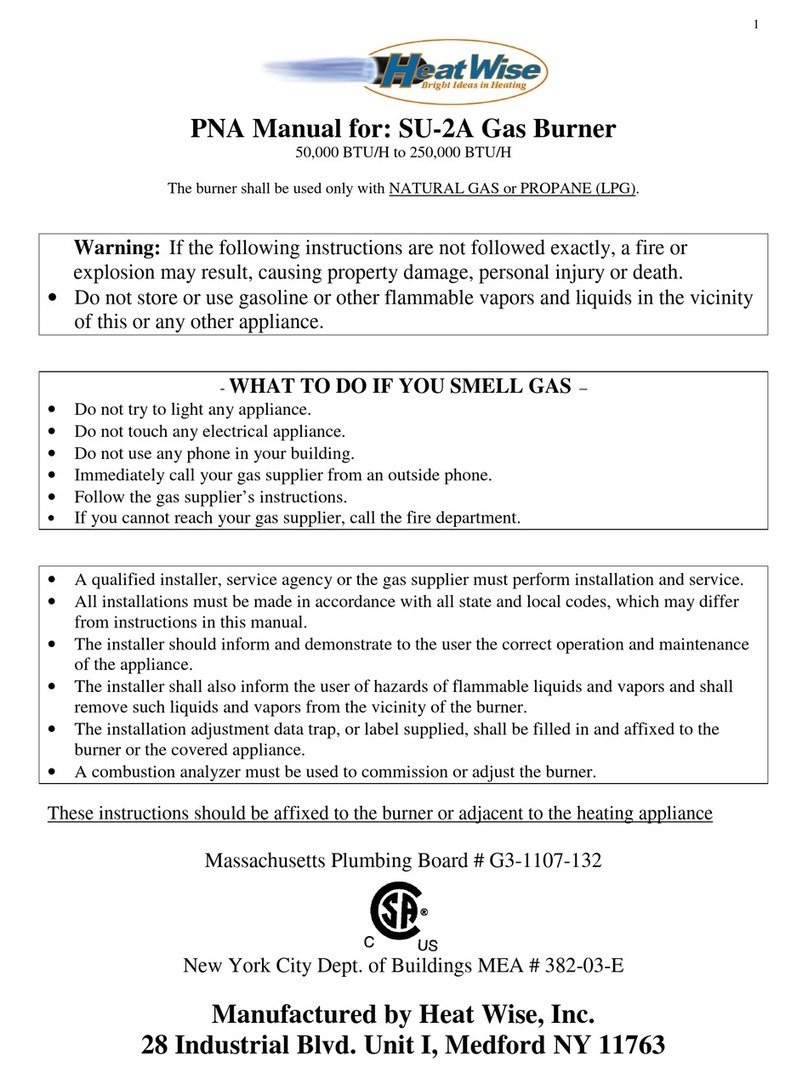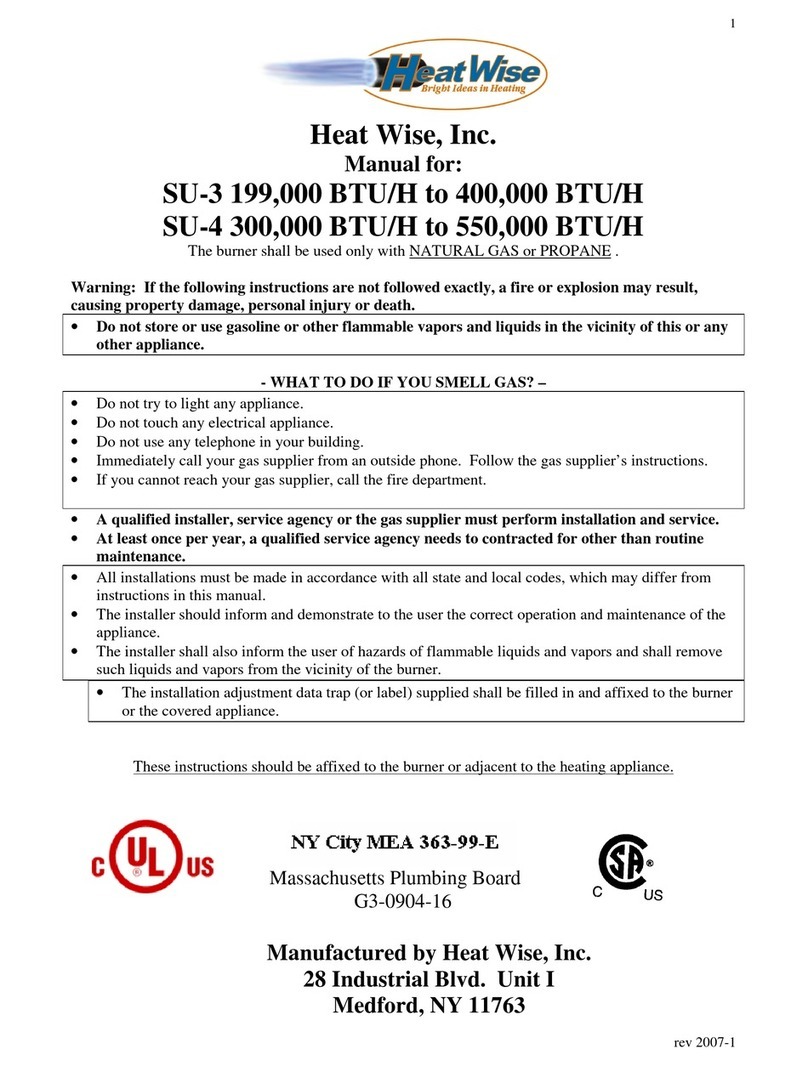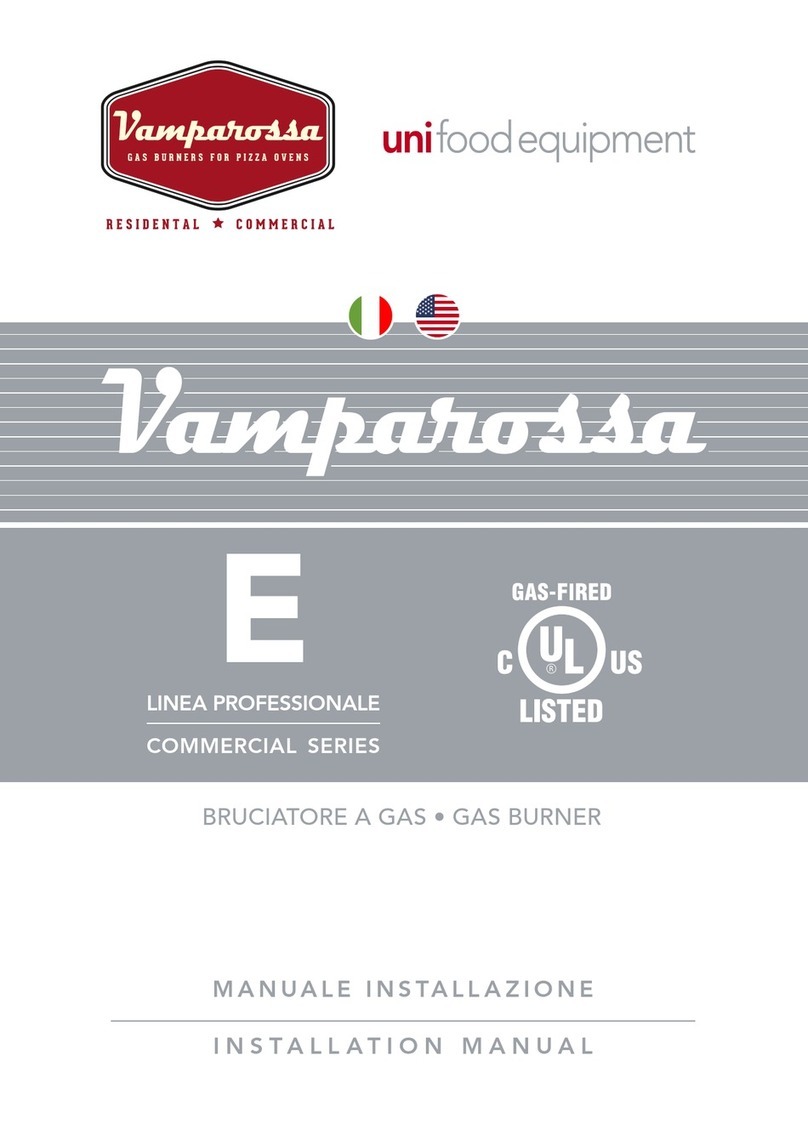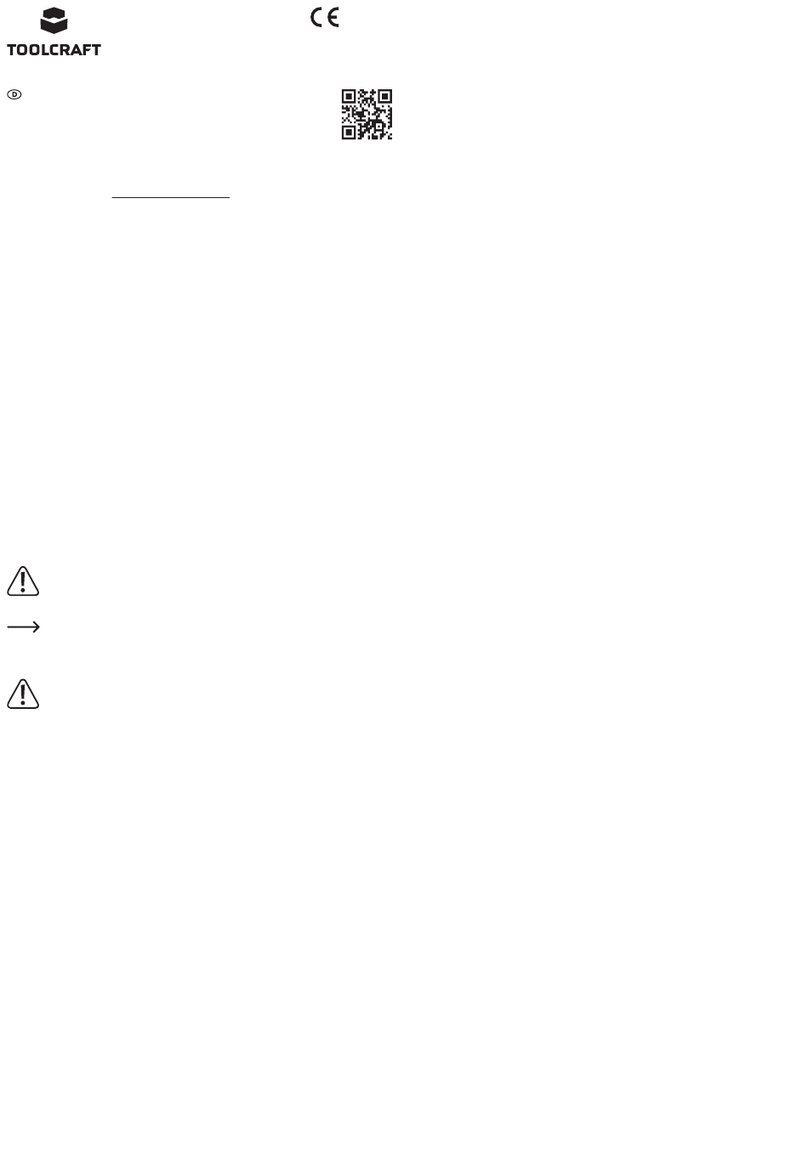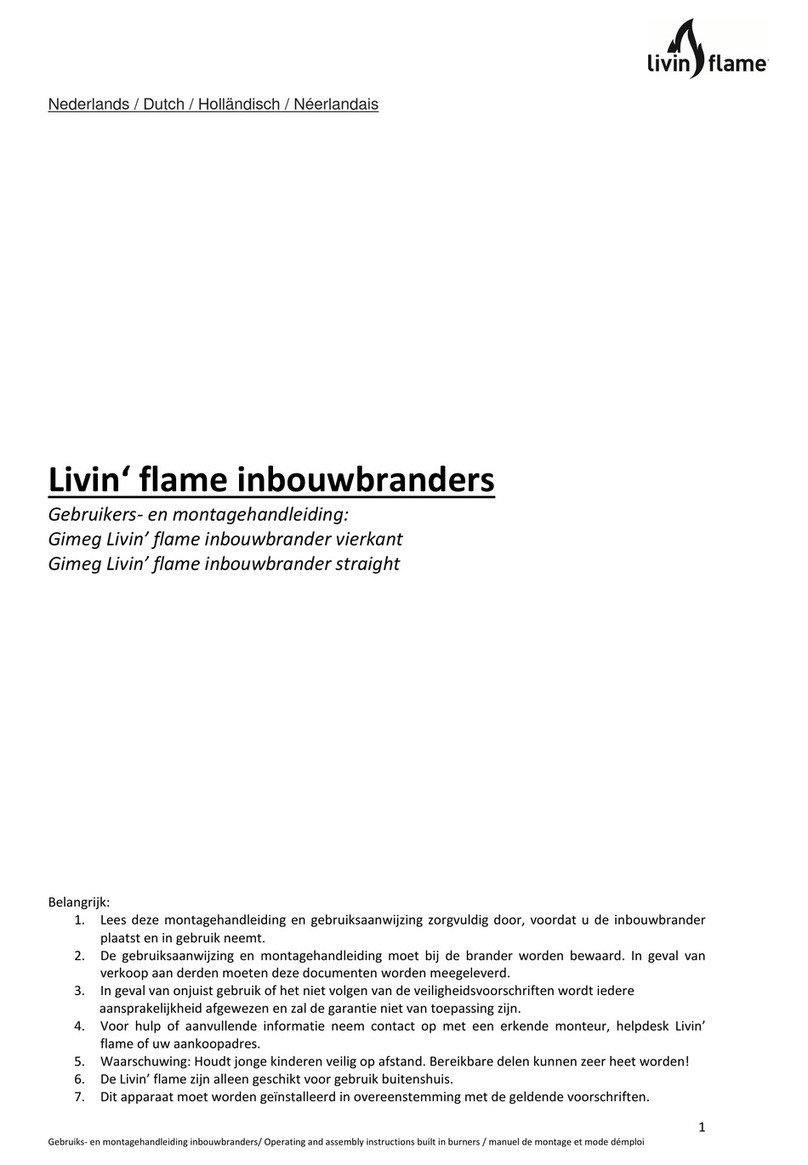Heat Wise SU-3 User manual

1
Heat Wise Inc.
Manual for: SU-3 Gas Burner
200,000 BTU/H to 400,000 BTU/H
The burner shall be used only with NATURAL GAS specified on the nameplate
.
Warning: If the following instructions are not followed exactly, a fire or
explosion may result, causing property damage, personal injury or death.
• Do not store or use gasoline or other flammable vapors and liquids in the
vicinity of this or any other appliance.
- WHAT TO DO IF YOU SMELL GAS? –
• Do not try to light any appliance.
• Do not touch any electrical appliance.
• Do not use any phone in your building.
• Immediately call your gas supplier from a neighbor’s phone. Follow the gas supplier’s
instructions.
• If you cannot reach your gas supplier, call the fire department.
• A qualified installer, service agency or the gas supplier must perform installation and
service.
• All installations must be made in accordance with all state and local codes, which may
differ from instructions in this manual.
• The installer should inform and demonstrate to the user the correct operation and
maintenance of the appliance.
• The installer shall also inform the user of hazards of flammable liquids and vapors and
shall remove such liquids and vapors from the vicinity of the burner.
• The installation adjustment data trap (or label) supplied shall be filled in and affixed to the
burner or the covered appliance.
These instructions should be affixed to the burner or adjacent to the heating appliance.
NY City MEA 363-99-E
Massachusetts Plumbing Board G1-0903-40:09/03/2004
Manufactured by Heat Wise, Inc.
1528 Rocky Point Road, Middle Island, NY 11953
rev 2004-1

2
Chart 1: Natural Gas ONLY
Firing RateBurner
Model Length
of
Flame
Tube Min
BTU/H Max
BTU/H
Primary
Electric
Input
Secondary
Electric
Input
Total
Watts Total
Amps Gas
Conn.
SU-3
5 ¼”
200,000
400,000 120 Volt
60 Hz
1 Ph
24 Volts
150
Max
3 or
less
½” or
1”
Control System: Fenwal Model 2466H936-111 with 15 Second Pre-Purge and 60 Second Post-Purge
OR Honeywell S89F with 34 second Pre-Purge.
Gas valve: Honeywell VR 8305
The system uses a remote ignition system using a separate Ignition Transformer.
The SU-3 Gas Burner is a fully automatic, flame retention burner and is suitable for combustion of
natural gas. Changing orifices alters the firing rate. The combustion air can be adjusted for
proper O
2
or CO
2
by the dial located on the back of the burner housing, which allows the air to
flow more or flow less within the burner.
Two electrodes act as a sparker and a flame rod (See Fig. 1). Flame rectification by this
flame rod monitors the continued presence of the burner flame. With three trials for ignition
consistency (with Fenwal control), trouble free, safe operation is achieved.
Warning: Should overheating occur, 1) shut off the manual gas shut off valve to
control the appliance; 2) DO NOT shut off the control switch to the pump or blower
This power gas burner is designed to convert oil and/or coal fired boilers and furnaces to a
gas-burning appliance. The conversion must conform to local codes. In the absence of such
codes, the American National Standard for the Installation of gas conversion burners, Z21.8A-
1990 and the National Fuel Gas Code ANSI 223.1-1992 or current standards should be
applied.
Fig. 1 Electrode and Flame Sensor Dimensions
Chart 2: Minimum Firing Chamber Dimensions
Rectangular Round
Input Rate
BTU Length Width Diameter Minimum
per hour Height
200,000 to
250,000
15"
8"
15"
13"

3
CONVERTING OIL TO GAS
Before attempting the gas conversion, check to insure the heating system is properly sized
for the total heating demand and the entire system is in good operating condition, including the
fire chamber and flue passages. It is important to allow adequate clearance around the appliance
for servicing and proper operation of the burner.
CONVERTING COAL TO GAS
When converting a coal appliance to gas, the coal firing chamber or the ash pit chamber
may be used as a gas firing chamber, provided the flame does not impinge on the walls of the
appliance (see Chart 2). It is important to allow adequate clearance around the appliance for
servicing and proper operation of the burner.
AIR FOR COMBUSTION
If the boiler or furnace room is unusually tight, or if the house has a ventilation fan, it is
recommended that the combustion air be supplied to the furnace room through intakes from the
outside of the building. The intakes must terminate facing down in order to avoid obstruction
from rain, snow, leaves, etc. Openings must have one square inch of free area per 10,000 BTU
input rate (see Example 1). Follow the heat exchanger manufacturer's recommendations for
installing louvers, etc.
Example 1: 280,000 BTU/hr firing rate
( )
(
)
2
2
28
/000,10
1
*/000,280 in
hrBTU
in
hrBTU =
Chart 2: Minimum Firing Chamber Dimensions
Rectangular Round
Input Rate
BTU Length Width Diameter Minimum
per hour Height
200,000 to
300,000
15"
8"
15"
13"
300,000 to
350,000 16" 14" 15" 15"
350,000 to
400,000 17" 15" 15" 15"

4
CHIMNEY REQUIREMENTS
The chimney should extend
at least 3’
above a flat roof or the highest roof ridge (see Fig.
2) and be free in a
radius of 30’
of objects such as tree limbs, other buildings, etc, which may
cause a down draft. The chimney should be lined as required by the local Gas Company or local
codes.
Some utilities require new chimney liners for all gas installations. Use a corrosion resistant
chimney liner (approved for gas service) of the same size as the vent pipe.
Fig. 2 Chimney and Fresh Air Dimensions

5
VENT PIPE AND DRAFT HOOD SIZES
Refer to Chart 3 to properly size the flue pipe. If the flue pipe exceeds 10’ in length
(including elbows), use the next larger diameter flue pipe and draft hood. If a draft regulator is
required, any Canadian Standards Association (CSA) or Underwriter’s Laboratory (UL) listed
double swing draft regulator must be used.
A movable internal damper is not permitted on gas
installations.
When the burner is used as a conversion burner, draft over fire should be maintained
as –0.02” W.C. by adjusting the regulator when the burner is fired. The installer should follow the
barometric draft regulator manufacturer’s instructions for complete details for installations and
adjustments. The vent pipe should extend only to (but not beyond) the inside wall of the chimney.
The sizing below does not apply on any factory listed packaged units
.
Chart 3: Vent Pipe Sizing
Input per Hour
Draft Hood and Flue Pipe Sizes
Up to 250,000 BTU
7” diameter
250,000 to 320,000 BTU
8” diameter
320,000 to 400,000 BTU
9” diameter
INSTALLING THE BURNER
If the burner being installed is a conversion burner, use a prefabricated chamber or build a firing
chamber that can withstand 2000
o
F (See Chart 2 on page 3). Measure the boiler or furnace
mounting plate to determine the flame tube insertion required.
Deduct ¼” from the total length
and tighten the flange on the flame tube with the deducted insertion depth. The ¼” deduction will
prevent the tip of the flame tube from burning off.
Install the burner on the unit and then tighten
the nuts on the flange so that the burner is permanently secured. Seal off any free openings with
high temperature cement.
Picture 1: STANDARD FLANGE:
Measure your insertion depth and mark the blast tube.
Deduct ¼” from the total length; the ¼” deduction will
prevent the tip of the flame tube from burning off. Remove
the blast tube by loosening the two 3 mm allen screws
located on the housing near the base of the blast tube.
Install the flange and gasket from the rear of the blast tube
and tighten the four ¼”-20 setscrews on the flange.
Reinstall the blast tube (with flange to the housing). Make
sure that the blast tube is firmly fixed to the burner. Mount
the burner to the heat exchanger and tighten the bolts. Seal
off any free openings with either high temperature cement
or high temperature silicone

6
GAS SERVICE & PIPE CAPACITY
Before connecting the burner to the gas supply, insure that the gas pipes and service meter
are large enough to permit the additional load of the gas burner (see Chart 4).
Chart 4: Pipe Capacity Table*( x 1,000 BTU’s)
Nominal diameter of pipe in inches
Pipe Length**
1” 1 ¼” 1 ½” 2”
15’
345 750
30’
241 535 850
45’
199 435 700
60’
173 380 610
75’
155 345 545
90’
141 310 490
105’
131 285 450 920
120’
120 270 380 850
150’
109 242 300 780
180’
100 225 225 720
* Using 0.6 Specific Gravity Gas and a Pressure Drop of 0.3” of Water Colum
n
**
Each 90
0
elbow counts as 3’ for the purpose of these calculations
Picture 2: BODY FLANGE:
First, install the gasket and boiler flange to the boiler. For
heat exchangers with a diamond stud pattern, one allen screw on
the flange should be on the top, slightly to the left of the 12 o’clock
stud. The second screw should be on the right (slightly above the 3
o’clock positi
on stud). Tighten all the nuts equally. Make sure that
the allen screws are backed out, to allow enough clearance. Then,
insert the SU-3 gas burner into the boiler.
Once the burner is inserted and pushed all the way forward,
tighten the allen screw on the top of the flange. This screw MUST
go into the groove that is on the burner housing.
Tighten the second allen screw, located on the right side of
the flange. This screw should be tight.
Seal off any free openings with either high temperature cement or
high temperature silicone
.

7
GAS INPUT ESTIMATE
Determine the required burner BTU input rate by multiplying the total BTU heating
plant by 1.2 or, for oil fired furnaces rated in gallons per hour, input 140,000 BTU’s per
gallon.Example 2: if the boiler or furnace is rated for 200,000 with oil, then:
200,000 x 1.2 = 240,000 BTU input rate.
If the boiler or furnace is rated for 2.0 GPH of No. 2 oil, then:
2.00 GPH x 140,000 = 280,000 BTU input rate.
Use the calculated input rate to fire the boiler or furnace.
GAS PIPING TO BURNER
It is advisable to run a separate gas line from the meter to the gas burner to avoid
pressure drops. Refer to the above Pipe Capacity table for the correct sizes.
ALL PIPING
MUST CONFORM WITH LOCAL CODES.
Use black steel pipe and malleable
fittings (do not use cast iron parts) with a suitable pipe dope that is resistant to liquefied
petroleum gases.
Piping should consist of:
1. A shut off valve approximately 6’ away from the unit.
2. A 1/8” plugged NPT tapping for gas pressure measurement preferably on the manual shut
off valve (as shown or anywhere between the gas valve and the shut off value).
Note: The manual shut off valve and tapping are NOT part of the SU-3 Gas Burner.
Please make sure you conform to local and state codes.
3. A gas union.
4. A drip pipe.
Caution: The gas valve should not be subjected to more than ½” PSIG. Therefore, the
burner should be isolated during high-pressure gas leak tests. The appliance and its
individual shut off valve must be disconnected from the gas supply piping system during
any pressure testing of that system at test pressures in excess of ½ psig. The appliance
must be isolated from the gas supply piping by closing its individual manual shut off valve
during any pressure testing of the gas supply piping system at test pressures equal to or
less than ½ psig.
The below dotted lines represent field installation.

8
Fig. 3 Gas Burner Piping*
*The dotted lines represent field installation.
INSTALLING THE CHIMNEY LINER, DRAFT DIVERTER AND
VENT PIPE
Some utilities require new chimney liners for all gas installations. Use a corrosion
resistant chimney liner (approved for gas service) of the same size as the vent pipe. Use an CSA
or U.L. listed draft diverter only if you can maintain draft over fire. Otherwise, it is better to use
a double swing draft regulator, listed by CSA or U.L. When the burner is used as a conversion
burner, draft over fire should be maintained as –0.02” W.C. by adjusting the regulator when the
burner is fired. The installer should follow the barometric draft regulator manufacturer’s
instructions for complete details for installations and adjustments. The vent pipe should extend
only to (but not beyond) the inside wall of the chimney.
ELECTRIC WIRING
These gas burners are manufactured for use with 120 volt, 60 cycle, single-phase electric
current. The installation must comply and be grounded in accordance with the National Board of
Fire Underwriters and National Electric Code ANSI/NFPA No. 70-1987 (or the latest addition).
All applicable local codes should be followed as well.
Installation wiring should be wired through each limit control or interlock, while operating
controls (like the thermostat) should be treated as 24-Volt wiring. The burner has its own 24
Volt AC power supply. Do not add a 24 Volt AC transformer for the burner wiring. Do not use
the 24 Volt transformer found on the burner to power other items in the heating system, such as
spill switches, etc. Follow the wiring diagrams provided below:

9
Fig. 4 Wiring Diagram for Fenwal 2466H
SEQUENCE OF OPERATIONS
Fenwal 2466H 036-111
1. All limits are closed and 120-volt power is on for the burner.
2. T-T terminals are closed (24-volt power carrying lines; do not power this.) Sometimes, T-T
terminals are jumped with a wire nut for burners not set for post-purge.
3. Burner motor starts and pre-purge begins
4. Burner housing pressurizes and proves air flow - contacts closed. {Note: if the contacts are closed
before the motor starts, blower motor runs continuously. Diagnostic light flashes once every 3
seconds.}
5. At the end of pre-purge, ignition spark starts (audible sound) and the redundant gas valve opens for
4 seconds. (Trial for ignition)
6. Within 4 seconds, gas flame is established and the flame rod carries current to prove the flame
{Note: a minimum of 0.7 micro amps are required; 5 micro amps is not uncommon.}
7. Flame remains till operating limit is open. If T-T is used to fire the burner (field wired for post-
purge), the burner will go into post-purge once the thermostat is satisfied (T-T open). These
burners have 60 seconds post purge.
8. If the flame is not established, the control will attempt ignition two more times before locking out
for 60 minutes. The control will then attempt to re-establish the flame every 60 minutes. To reset
the control, interrupt power for five minutes to start the sequence again.

10
Fig. 5 Wiring Diagram for Honeywell S89F
SEQUENCE OF OPERATIONS
Honeywell S89F
1. Limits close.
2. Blower motor starts as the 24 Volt transformer powers the airflow switch.
3. Power from the airflow switch to the S89F control initiates 34 second pre-purge.
4. At the end of the pre-purge, the spark is energized for 4 seconds. At the same time, the 24 Volt
transformer powers the gas valve, allowing the fuel to flow.
5. Within 4 seconds, the flame should be established and proved. The spark will shut off and the
control will hold power to the gas valve until the limits open and the burner stops firing.
6. If the flame is not established, the blower motor continuously runs.
7.
To restart, power should be interrupted for five minutes. Then turn on the power to start this
sequence again
.

11
ORIFICE INSTALLATION (Optional)
Some OEM packaged burners are equipped with an orifice. Drilling the orifice increases
the firing rate. To drill the orifice, first open the union and then unscrew the orifice from inside
the union. Determine the proper orifice size for the desired firing rate and drill the orifice (see
Chart 5). Replace the orifice in the union and tighten the union so that it is gas tight. Once
installed, a higher or lower firing rate can be achieved by raising or lowering the manifold
pressure by +/- 0.3”. Pressure changes can only be made when the burner is running. The typical
working manifold pressure for natural gas is
3.5” W.C
. (2.3” W.C. for LP). The maximum inlet
pressure at the gas valve is
11” W.C
.; the minimum is
5” W.C.
Note: The manifold pressure may vary for OEM packaged units.
Chart 5: BURNER ORIFICE SIZING
FOR NATURAL GAS
Orifice Size in inches Drill Size
Manifold Pressure at
3.5" W.C.
25/64 .390
200,000
27/64 .4218
225,000
29/64 .453
250,000
1/2 .500
275,000
9/16 .560
300,000
11/16 .6875
350,000
7/8 .875
400,000
ADJUSTING THE FIRING RATE
By adjusting the head and manifold pressure, the SU-3 can be adjusted for various firing
rates (200,000 to 400,000 BTU). The retention head is 2.2” inside the tube when the marking
reads ‘0’. There is a full ½” movement of the retention disk to move forward (to increase
secondary air) or backwards (to decrease secondary air). This movement can also be used to
compensate for back pressure in the combustion area, up to 0.3” W.C.
CAUTION: If this is the case, the flange and the combustion chamber should be
completely sealed. This pressure firing decreases as the firing rate increases.
See Fig. 6 below. Position D
1
represents the burner head all the way forward. By rotating the
burner head adjustment screw
clockwise
, the head can be moved back 0.5” (to position D
3
).
Similarly, if the head adjustment screw is turned
counter-clockwise
, the head is moved forward.
At head position D
3
, the SU-3 gas burner fires at 300,000 BTU when the gas manifold pressure is
3.5” W.C. Adjust the air shutter and use a combustion analyzer to set the burner to between 9%
and 10% CO
2
(See page 13 of this manual for further details on burner operation).
By adjusting the manifold pressure, it is possible to adjust the firing rate. Refer to Chart 6.
Note: The pressure and head setting may vary for OEM packaged units.

12
Fig. 6 Adjusting the Firing Rate
Chart 6: Firing Rates at Various Settings
Manifold Pressure = 1.0” Manifold Pressure = 2.75” Manifold Pressure = 3.5”
Head Setting
# Air Shutter
# KBTU Head Setting
# Air Shutter
# KBTU Head Setting
# Air Shutter
# KBTU
1 0.18 224 1 10.01 344 1 16.74 395
2 0.25 225 2 10.19 344 2 16.97 395
3 0.32 227 3 10.37 346 3 17.19 396
4 0.39 230 4 10.55 351 4 17.42 400
5 0.46 234 5 10.72 359
6 0.53 238 6 10.90 367
7 0.60 242 7 11.08 376
8 0.67 247 8 11.26 384
9 0.74 251 9 11.44 392
10 0.81 254 10 11.61 399
11 0.88 258 11 11.79 400

13
LIGHTING INSTRUCTIONS
To light the SU-3 Gas Burner
1. Set the thermostat to the lowest
temperature
2. The control knob on the gas
valve should be in the “OFF”
position for at least five minutes.
3. Rotate the control knob counter-
clockwise to the “ON” position
and set the thermostat to the
desired temperature settings
Reset, if Flame Lockout Occurs
1. Turn the thermostat off, or turn the main power off
2. Wait five minutes
3. Turn the main power on
To shut the burner off
1. Rotate the control knob on the gas valve to the
“OFF” position
2. Set the thermostat to the lowest temperature
BURNER OPERATION
Before turning the burner on, check for gas supply leaks. Check the wiring diagrams; install
manometers before and after the gas valve. Keep the observation port of the boiler or furnace
open. Follow the instructions on the nameplate of the burner to turn it on. Follow the sequence of
operations for the control (see pages 8 and 9). Record the readings below.
BURNER OPERATION: Record the Readings at Steady State
Draft over fire at steady state (should be –0.02 “W.C. or zero)
Natural Gas CO
2
% = (9.0% to 9.8%) or O
2
% = (5.0% to 3.5%)
Stack Temperature (300
o
F minimum, 550
o
F maximum)
Percentage of Carbon Monoxide (CO) in PPM
Incoming Gas/LP pressure = “W.C. (minimum 5”)
Natural Gas manifold gas pressure = “W.C. (3.5” required + - 0.3”)
Carbon Monoxide in flue ( less than 100 PPM ideal; should not exceed 400PPM)
Maintenance Instructions
: TO BE FIXED/ATTACHED NEAR BURNER
Once a year, a qualified service agency needs to be contracted for other than routine maintenance.
1. The blower motor is the only moving part. It does not require lubrication, since the ball bearings have
been permanently lubricated.
2. The user should do periodic visual checks of the burner and the flame.
3. Laundry lint or dog and/or cat hairs should not go inside the blower. If they are seen, they should be
removed after disconnecting the power to the burner and cover parts should be installed before starting the
burner.
4. Keep the area around the conversion burner clear and free from combustible materials, gasoline, and
other flammable vapors and liquids.
5. No obstruction for the flow of combustion and ventilating air (ref. Page 4).

14
Trouble shooting:
There are three factors to operate the gas burner properly:
1. Electricity {(main Power 120V/60 Hz /1 Ph)( secondary 24V)}
2. Gas flow (Incoming pressure should be 10” w.c. with proper gas line without pressure
drop during burner operation).
3. Combustion air.
Check these three items properly before proceeding in detail for other problems.
Condition Solutions
1. Burner motor runs and:
No flame after pre-purge & no fuel indicator (where
applicable) Check 24V feed to airflow switch & after airflow
switch to control. Fix or replace the airflow switch.
If there is no secondary power, then replace the
24Vtransformer.
No flame, fuel indicator on (where applicable),
faulty ignition transformer or spark separately Check ignition transformer, electrode, cracked
electrode or gap. Fix or replace.
Fenwal control defective after above tests. Replace
2. Burner locks out after 4 seconds
First, check ionization electrode, ionization cable
(for cracks) and boot. Fix as needed.
Polarity reversed Check power feed for broken polarity
Bad earth grounding Fix the ground wire
Gas pressure is too low Check the gas pressure and adjust to proper pressure
3. Pulsation at start
First, check the burner head location with respect to
the end of the flame tube. Adjust as necessary.
Gas pressure is too high. Use manometer and readjust the pressures.
Blocked Flue Check draft and clear flue of foreign materials.
4. Pulsation during operation
Burner is not correctly adjusted. Readjust with combustion analyzer.
The burner is dirty. Clean the burner.
Defective chimney Check and change if necessary with liners.
5. Burner locks out
Ionization current is too low. Check current. Minimum 0.8 micro amps. Check
position of ionization electrode and the condition of
the cable.
6. The CO content is too high
Excess air is too high or too low. Adjust air shutter.
The gas holes are clogged. Clean them.
The fresh air intakes are too small. Check and readjust.
The burner head is out of position. Check and readjust.
7. Condensation in the heat exchanger
Firing Rate is too low. Increase the firing rate so that the stack temperature
is 350
o
F or HIGHER. Insulate the chimney.

15
ITEM PART PART # ITEM PART PART #
1 Blast Tube
1175-1701 16 Cover Plate - Air
Regulation
1188-7401
2 Flange Gasket
10195-1 16A Cover Plate - Nozzle
Line
1188-7302
3 Adjustable Flange 10195 17 Scale - Nozzle Line
1188-8501
4 Front piece - Housing 17A Scale - Air Regulation
1188-7801
5 Rear piece – Housing
18 24 Volt Transformer 2440VA
6 Fan Wheel - 146 mm
(optional 133 mm)
1187-2601
(1186-7101)
19 Safety Control 2466H or
S89F
7 1/6 HP PSC Blower motor
D82132 20 Plastic Cover Plate 11850001
8 Shielding Plate Housing
21 Screw (Long Special) 1175-0702
9 Outside Air Boot (optional)
83296 22 Airflow Switch
Honeywell/Tridelta
6041A
9A Silencer (optional)
11909-
60105
23 Ignition Electrode 1153-4704
10 Air Regulation Plate
1186-7401 24 Flame Rod 1153-4703
11 Air Damper
1186-7501 25 Retention head 1193-8501
12 Air Regulation Adjustment screw
1184-8401 26 Union 113-9101
13 Adjustment Screw – Nozzle Line
1191-2901
14 Ionization Cable
1186-5805
27
Gas Valve
VR 8305
15 Ignition Transformer (cable included) 2709 or
5SAY

16
Other manuals for SU-3
2
Table of contents
Other Heat Wise Burner manuals
Popular Burner manuals by other brands

Jøtul
Jøtul GF 305 DV IPI Guide
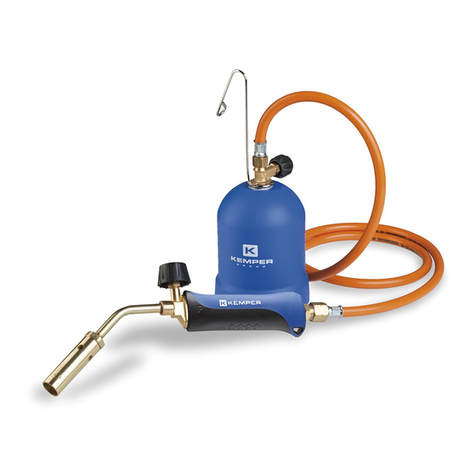
Kemper
Kemper 1217 Instructions for use
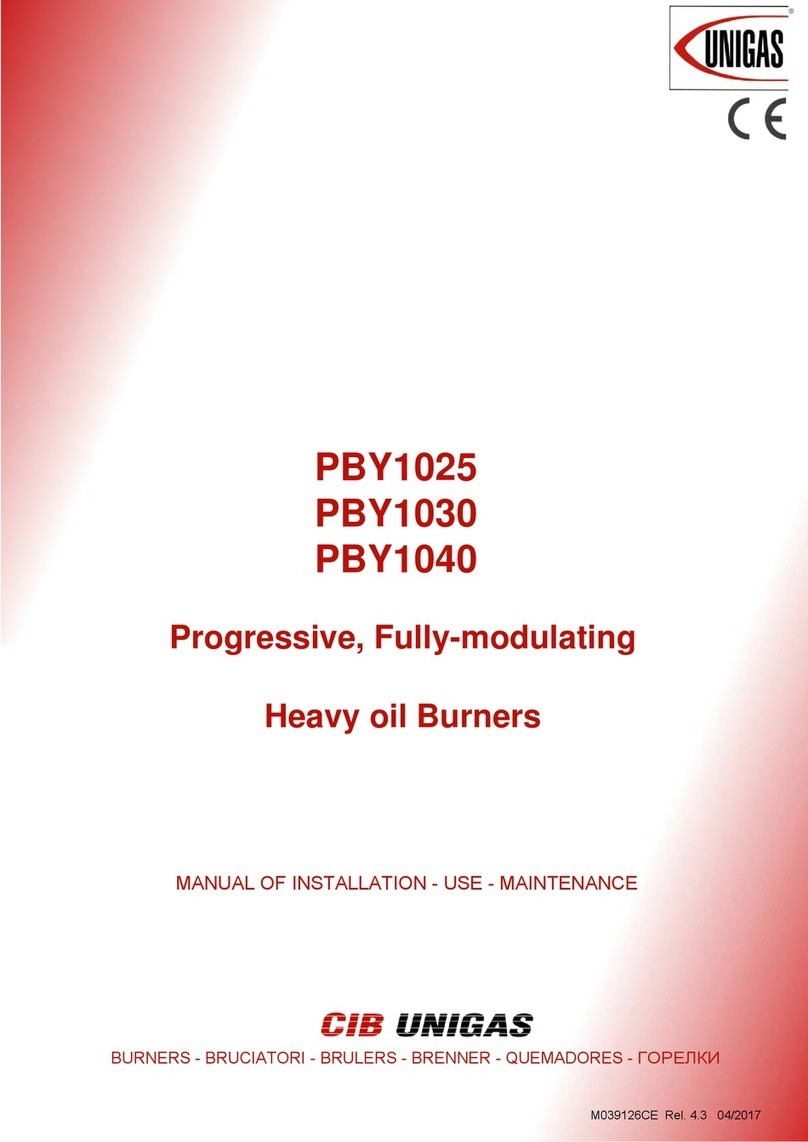
CIB UNIGAS
CIB UNIGAS PBY1030 Manual of installation - use - maintenance
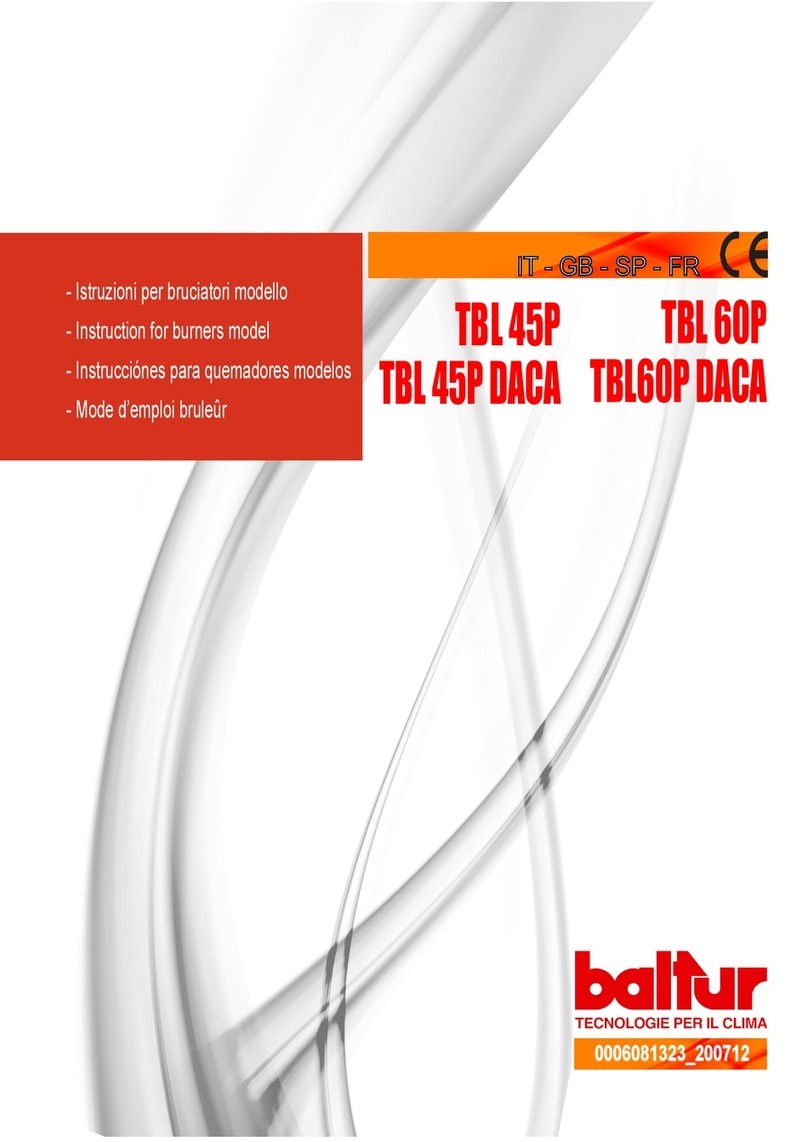
baltur
baltur TB L 45P instructions
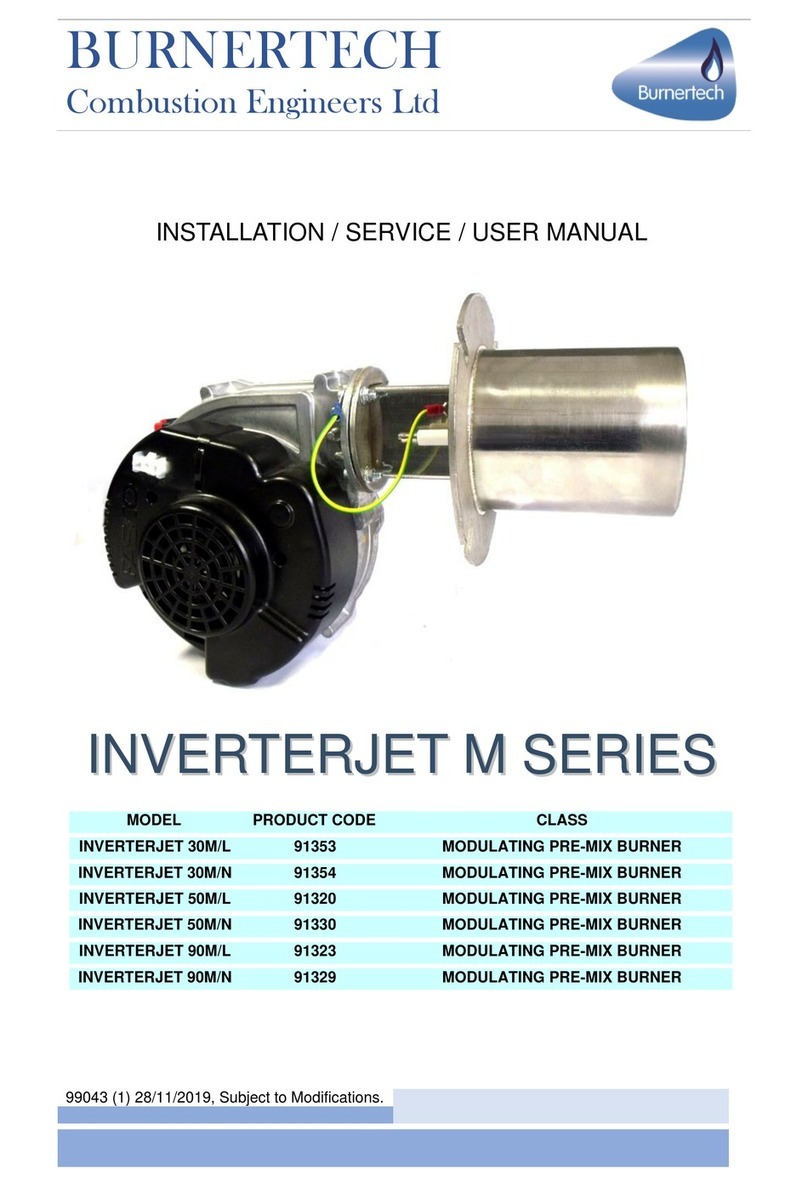
Burnertech
Burnertech INVERTERJET M Series INSTALLATION / SERVICE / USER MANUAL
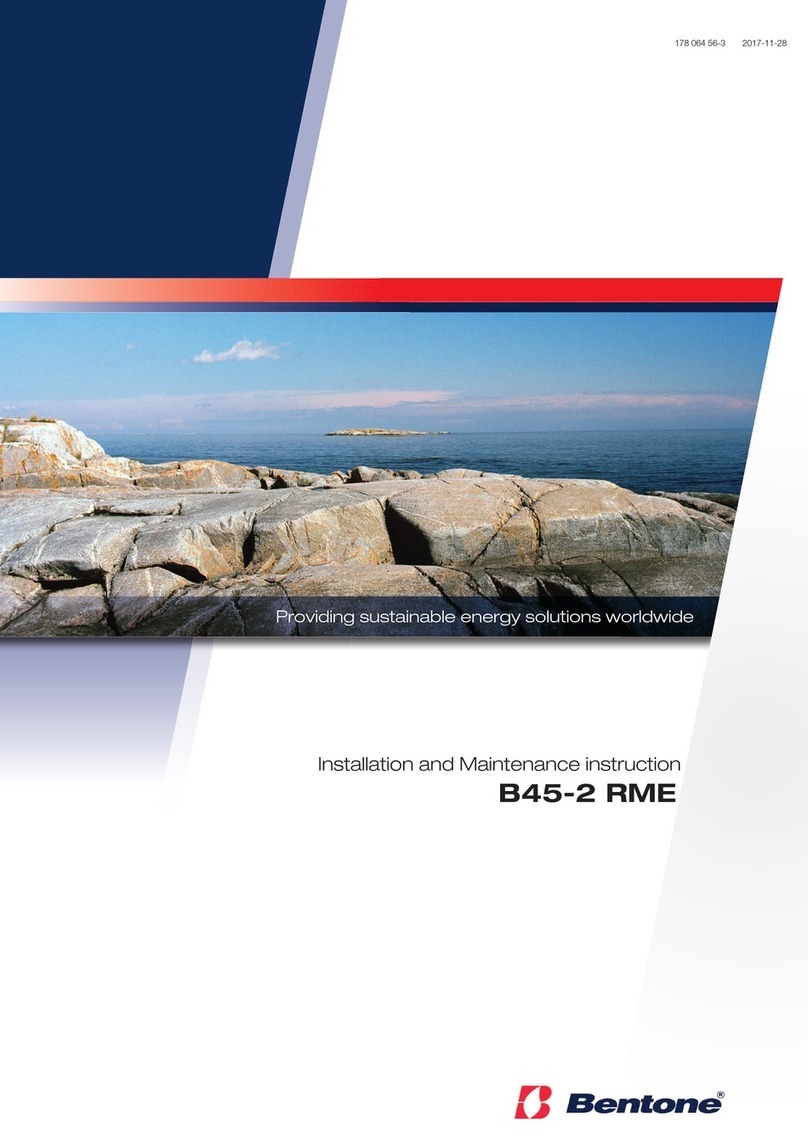
Bentone
Bentone B45-2 RME Installation and maintenance instruction
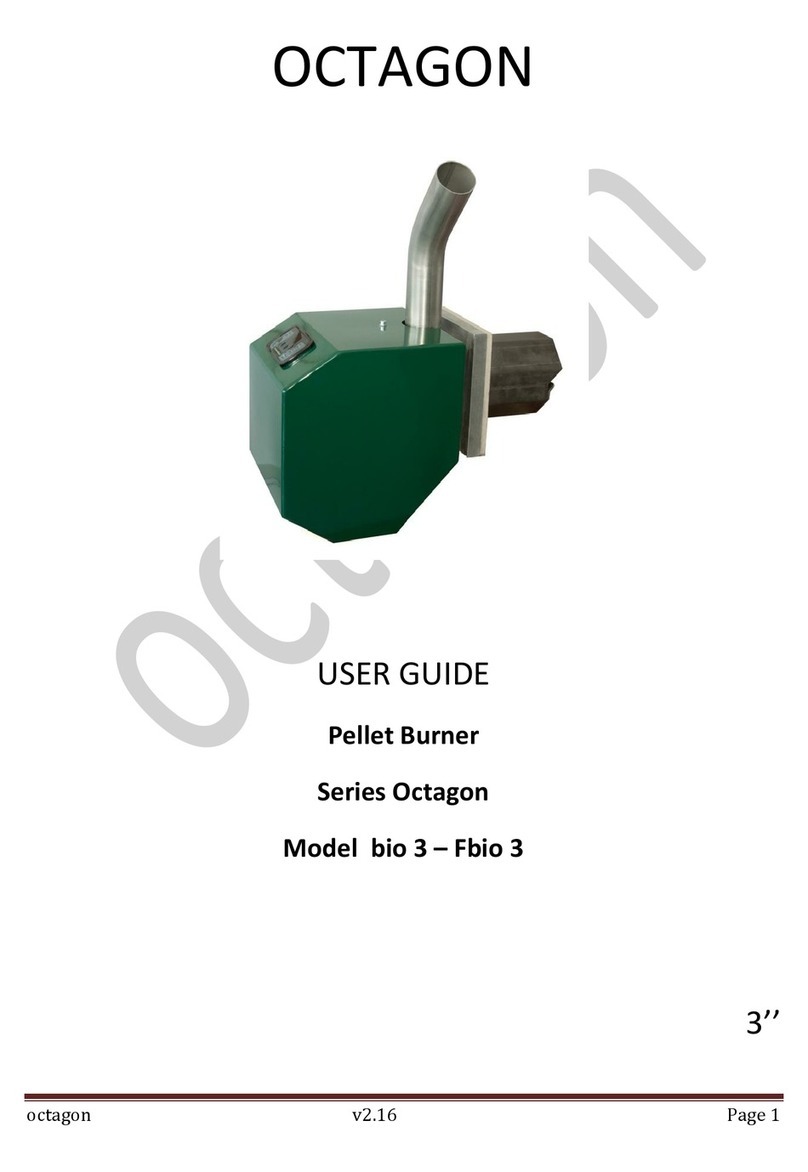
Octagon
Octagon bio 3 user guide

Ecosmar+
Ecosmar+ XL700 user manual
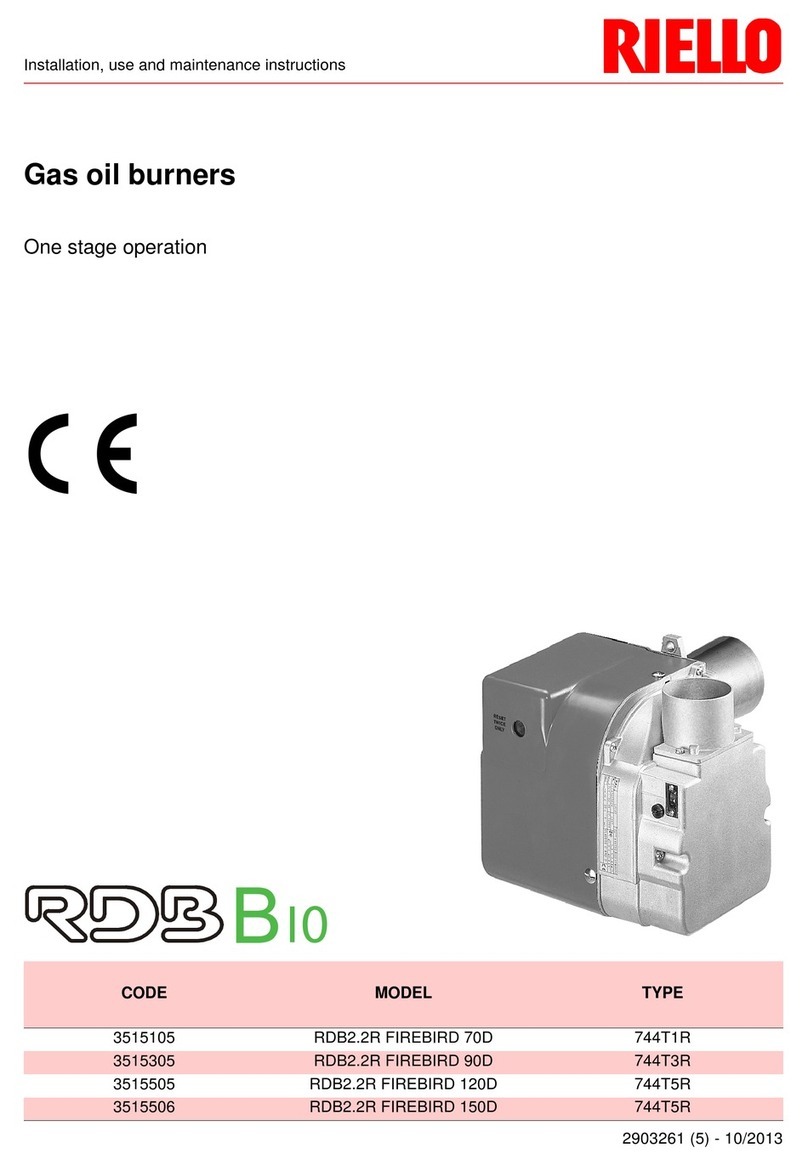
Riello
Riello RDB B10 Installation, use and maintenance instructions
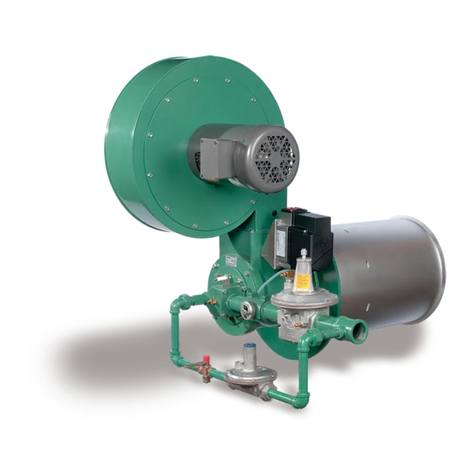
Honeywell
Honeywell Eclipse WX0050 operating instructions
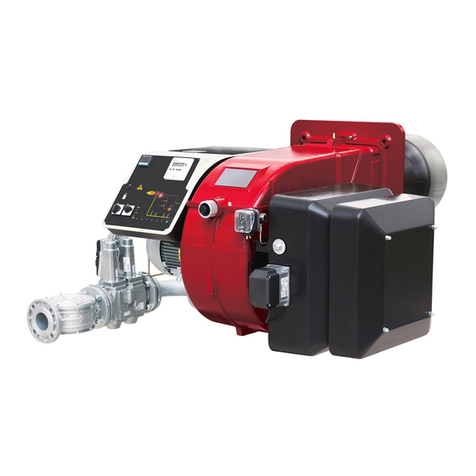
CIB UNIGAS
CIB UNIGAS R91A Installation, use & maintenance manual
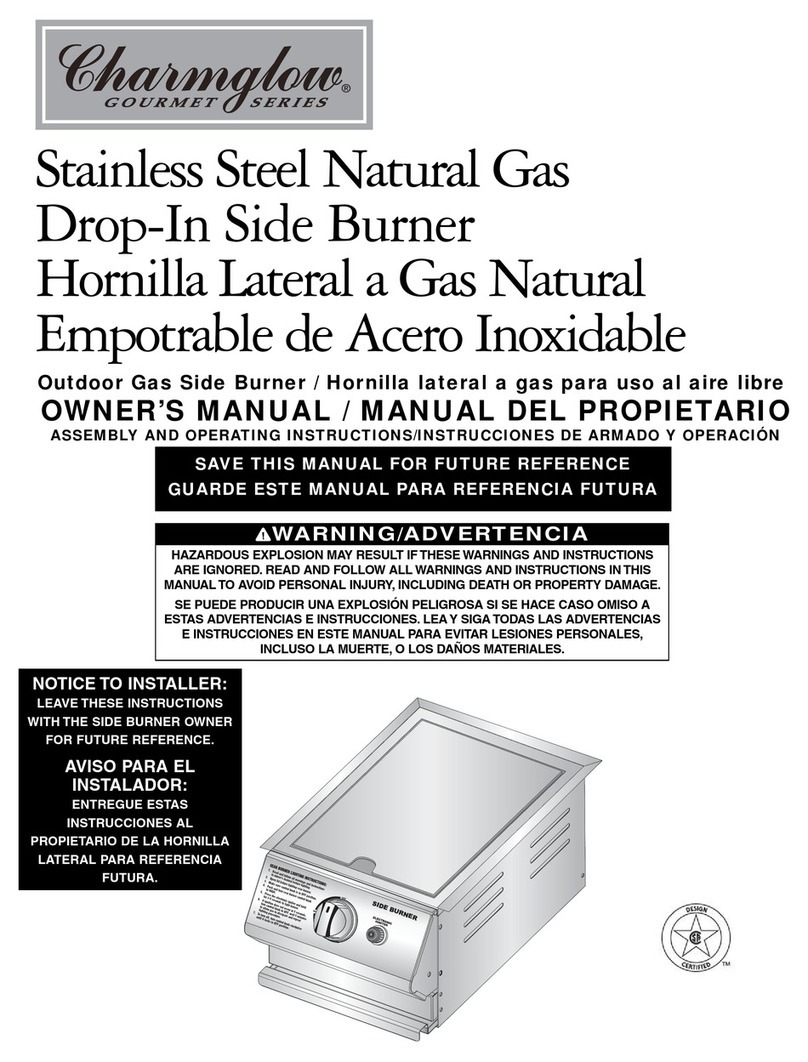
Charmglow
Charmglow Gourmet Series owner's manual
